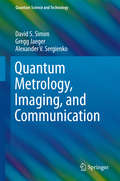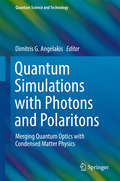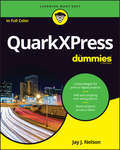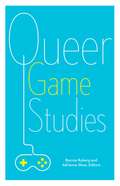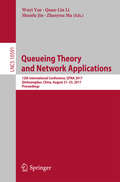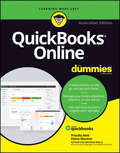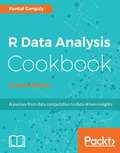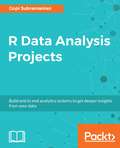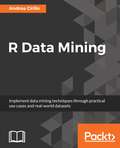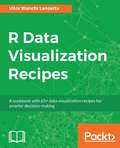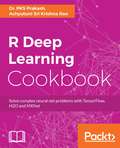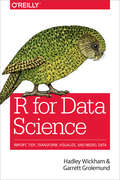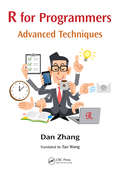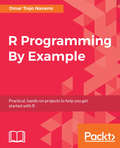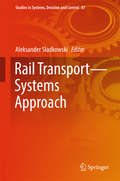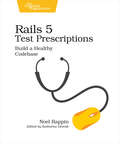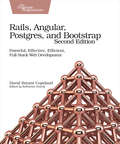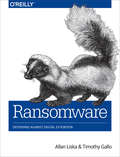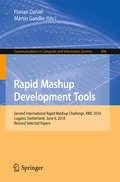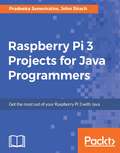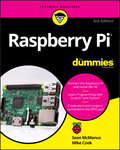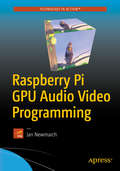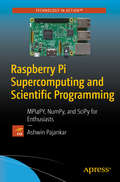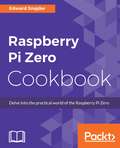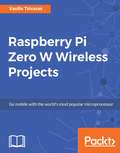- Table View
- List View
Quantum Metrology, Imaging, and Communication
by David S. Simon Gregg Jaeger Alexander V. SergienkoThis book describes the experimental and theoretical bases for the development of specifically quantum-mechanical approaches to metrology, imaging, and communication. In particular, it presents novel techniques developed over the last two decades and explicates them both theoretically and by reference to experiments which demonstrate their principles in practice. The particular techniques explored include two-photon interferometry, two-photon optical aberration and dispersion cancellation, lithography, microscopy, and cryptography.
Quantum Simulations with Photons and Polaritons
by Dimitris G. AngelakisThis book reviews progress towards quantum simulators based on photonic and hybrid light-matter systems, covering theoretical proposals and recent experimental work. Quantum simulators are specially designed quantum computers. Their main aim is to simulate and understand complex and inaccessible quantum many-body phenomena found or predicted in condensed matter physics, materials science and exotic quantum field theories. Applications will include the engineering of smart materials, robust optical or electronic circuits, deciphering quantum chemistry and even the design of drugs. Technological developments in the fields of interfacing light and matter, especially in many-body quantum optics, have motivated recent proposals for quantum simulators based on strongly correlated photons and polaritons generated in hybrid light-matter systems. The latter have complementary strengths to cold atom and ion based simulators and they can probe for example out of equilibrium phenomena in a natural driven-dissipative setting. This book covers some of the most important works in this area reviewing the proposal for Mott transitions and Luttinger liquid physics with light, to simulating interacting relativistic theories, topological insulators and gauge field physics. The stage of the field now is at a point where on top of the numerous theory proposals; experiments are also reported. Connecting to the theory proposals presented in the chapters, the main experimental quantum technology platforms developed from groups worldwide to realize photonic and polaritonic simulators in the laboratory are also discussed. These include coupled microwave resonator arrays in superconducting circuits, semiconductor based polariton systems, and integrated quantum photonic chips. This is the first book dedicated to photonic approaches to quantum simulation, reviewing the fundamentals for the researcher new to the field, and providing a complete reference for the graduate student starting or already undergoing PhD studies in this area.
QuarkXPress For Dummies
by Jay J. NelsonTake the kinks out of working with QuarkXPress QuarkXPress still remains one of the top tools for layout and design projects, even thirty years after it made its debut. This full-color, hands-on guide is here to help you take the guesswork out of using this powerful tool to create stunning print or digital designs. In QuarkXPress For Dummies, you'll find information on the latest changes to QuarkXPress, easy-to-follow, step-by-step guidance on using the tools built into the software to aid in designing and outputting visual product, and quick solutions to common Quark problems when you get stuck. QuarkXPress dominated the page layout world for decades. It's stuck around thanks to how it readily adapts to customer needs. This new version contains updates and features driven solely by customer feedback. That responsiveness is luring new and former users to the fold. That resurgence in the design community has Quark users clamoring for an authoritative book on how to use it to its fullest. Created in partnership with the pros at Quark, this is the book for new and experienced QuarkXPress users looking to make sense of the latest version. Offers unbeatable tricks for working with text Provides guidance on managing larger design projects Includes tips on how to correct mistakes Take a tour of the palettes, add style to your work, and make QuarkXPress work for you!
Queer Game Studies
by Adrienne Shaw Bonnie RubergVideo games have developed into a rich, growing field at many top universities, but they have rarely been considered from a queer perspective. Immersion in new worlds, video games seem to offer the perfect opportunity to explore the alterity that queer culture longs for, but often sexism and discrimination in gamer culture steal the spotlight. Queer Game Studies provides a welcome corrective, revealing the capacious albeit underappreciated communities that are making, playing, and studying queer games.These in-depth, diverse, and accessible essays use queerness to challenge the ideas that have dominated gaming discussions. Demonstrating the centrality of LGBTQ issues to the gamer world, they establish an alternative lens for examining this increasingly important culture. Queer Game Studies covers important subjects such as the representation of queer bodies, the casual misogyny prevalent in video games, the need for greater diversity in gamer culture, and reading popular games like Bayonetta, Mass Effect, and Metal Gear Solid from a queer perspective. Perfect for both everyday readers and instructors looking to add diversity to their courses, Queer Game Studies is the ideal introduction to the vast and vibrant realm of queer gaming. Contributors: Leigh Alexander; Gregory L. Bagnall, U of Rhode Island; Hanna Brady; Mattie Brice; Derek Burrill, U of California, Riverside; Edmond Y. Chang, U of Oregon; Naomi M. Clark; Katherine Cross, CUNY; Kim d’Amazing, Royal Melbourne Institute of Technology; Aubrey Gabel, U of California, Berkeley; Christopher Goetz, U of Iowa; Jack Halberstam, U of Southern California; Todd Harper, U of Baltimore; Larissa Hjorth, Royal Melbourne Institute of Technology; Chelsea Howe; Jesper Juul, Royal Danish Academy of Fine Arts; merritt kopas; Colleen Macklin, Parsons School of Design; Amanda Phillips, Georgetown U; Gabriela T. Richard, Pennsylvania State U; Toni Rocca; Sarah Schoemann, Georgia Institute of Technology; Kathryn Bond Stockton, U of Utah; Zoya Street, U of Lancaster; Peter Wonica; Robert Yang, Parsons School of Design; Jordan Youngblood, Eastern Connecticut State U.
Queueing Theory and Network Applications: 12th International Conference, QTNA 2017, Qinhuangdao, China, August 21-23, 2017, Proceedings (Lecture Notes in Computer Science #10591)
by Wuyi Yue, Quan-Lin Li, Shunfu Jin and Zhanyou MaThis book constitutes the proceedings of the 12th International Conference on Queueing Theory and Network Applications, QTNA 2017, held in Qinhuangdao, China, in August 2017. The 19 full papers included in this volume were carefully reviewed and selected from 65 initial submissions. They deal with queueing models; queueing applications; and network models.
QuickBooks Online For Dummies Australian Edition
by Elaine Marmel Priscilla MeliOrganise business finances with the latest cloud-based accounting innovation QuickBooks Online For Dummies, Australian Edition is your key guide to getting business finances under control. From budgeting and payroll to tax, inventory, accounts and beyond, this book shows you everything you need to know to keep the cash flow flowing. Whether you're a small business owner, accountant or bookkeeper, this guide walks you through essential bookkeeping tasks, and hands-on tutorials provide quick and practical instruction using the QuickBooks Online and QuickBooks Online Accountant cloud-based accounting solution. Stop juggling files and notes and calendars, stressing about what's due, what's coming and what you may have overlooked; this book shows you how to track and manage everything in one place, with alerts, reminders and detailed reports that help you gain a clearer picture of the business's financial state -- and all you need is an internet connection. Using the many helpful, timesaving features of QuickBooks Online and QuickBooks Online Accountant to their utmost capability requires a little insider knowledge and hands-on instruction; this book has you covered, with clear, practical guidance to help you: Manage payroll, invoices and accounts payable Track inventory, costs and expenses Create reports and simplify tax return preparation Organise finances in one intuitive place Wouldn't you enjoy the peace of mind that comes from knowing that your finances are under control? Wouldn't you prefer the freedom to access the books on any device, at any time? QuickBooks Online can help with that, and QuickBooks Online For Dummies, Australian Edition is the ultimate guide to working with the latest innovation in cloud-based accounting.
R Data Analysis Cookbook - Second Edition
by Kuntal GangulyOver 80 recipes to help you breeze through your data analysis projects using R About This Book • Analyse your data using the popular R packages like ggplot2 with ready-to-use and customizable recipes • Find meaningful insights from your data and generate dynamic reports • A practical guide to help you put your data analysis skills in R to practical use Who This Book Is For This book is for data scientists, analysts and even enthusiasts who want to learn and implement the various data analysis techniques using R in a practical way. Those looking for quick, handy solutions to common tasks and challenges in data analysis will find this book to be very useful. Basic knowledge of statistics and R programming is assumed. What You Will Learn • Acquire, format and visualize your data using R • Using R to perform an Exploratory data analysis • Introduction to machine learning algorithms such as classification and regression • Get started with social network analysis • Generate dynamic reporting with Shiny • Get started with geospatial analysis • Handling large data with R using Spark and MongoDB • Build Recommendation system- Collaborative Filtering, Content based and Hybrid • Learn real world dataset examples- Fraud Detection and Image Recognition In Detail Data analytics with R has emerged as a very important focus for organizations of all kinds. R enables even those with only an intuitive grasp of the underlying concepts, without a deep mathematical background, to unleash powerful and detailed examinations of their data. This book will show you how you can put your data analysis skills in R to practical use, with recipes catering to the basic as well as advanced data analysis tasks. Right from acquiring your data and preparing it for analysis to the more complex data analysis techniques, the book will show you how you can implement each technique in the best possible manner. You will also visualize your data using the popular R packages like ggplot2 and gain hidden insights from it. Starting with implementing the basic data analysis concepts like handling your data to creating basic plots, you will master the more advanced data analysis techniques like performing cluster analysis, and generating effective analysis reports and visualizations. Throughout the book, you will get to know the common problems and obstacles you might encounter while implementing each of the data analysis techniques in R, with ways to overcoming them in the easiest possible way. By the end of this book, you will have all the knowledge you need to become an expert in data analysis with R, and put your skills to test in real-world scenarios. Style and Approach • Hands-on recipes to walk through data science challenges using R • Your one-stop solution for common and not-so-common pain points while performing real-world problems to execute a series of tasks. • Addressing your common and not-so-common pain points, this is a book that you must have on the shelf
R Data Analysis Projects
by Gopi SubramanianGet valuable insights from your data by building data analysis systems from scratch with R. About This Book • A handy guide to take your understanding of data analysis with R to the next level • Real-world projects that focus on problems in finance, network analysis, social media, and more • From data manipulation to analysis to visualization in R, this book will teach you everything you need to know about building end-to-end data analysis pipelines using R Who This Book Is For If you are looking for a book that takes you all the way through the practical application of advanced and effective analytics methodologies in R, then this is the book for you. A fundamental understanding of R and the basic concepts of data analysis is all you need to get started with this book. What You Will Learn • Build end-to-end predictive analytics systems in R • Build an experimental design to gather your own data and conduct analysis • Build a recommender system from scratch using different approaches • Use and leverage RShiny to build reactive programming applications • Build systems for varied domains including market research, network analysis, social media analysis, and more • Explore various R Packages such as RShiny, ggplot, recommenderlab, dplyr, and find out how to use them effectively • Communicate modeling results using Shiny Dashboards • Perform multi-variate time-series analysis prediction, supplemented with sensitivity analysis and risk modeling In Detail R offers a large variety of packages and libraries for fast and accurate data analysis and visualization. As a result, it's one of the most popularly used languages by data scientists and analysts, or anyone who wants to perform data analysis. This book will demonstrate how you can put to use your existing knowledge of data analysis in R to build highly efficient, end-to-end data analysis pipelines without any hassle. You'll start by building a content-based recommendation system, followed by building a project on sentiment analysis with tweets. You'll implement time-series modeling for anomaly detection, and understand cluster analysis of streaming data. You'll work through projects on performing efficient market data research, building recommendation systems, and analyzing networks accurately, all provided with easy to follow codes. With the help of these real-world projects, you'll get a better understanding of the challenges faced when building data analysis pipelines, and see how you can overcome them without compromising on the efficiency or accuracy of your systems. The book covers some popularly used R packages such as dplyr, ggplot2, RShiny, and others, and includes tips on using them effectively. By the end of this book, you'll have a better understanding of data analysis with R, and be able to put your knowledge to practical use without any hassle. Style and approach This book takes a unique, learn-as-you-do approach, as you build on your understanding of data analysis progressively with each project. This book is designed in a way that implementing each project will empower you with a unique skill set, and enable you to implement the next project more confidently.
R Data Mining
by Andrea CirilloMine valuable insights from your data using popular tools and techniques in R About This Book • Understand the basics of data mining and why R is a perfect tool for it. • Manipulate your data using popular R packages such as ggplot2, dplyr, and so on to gather valuable business insights from it. • Apply effective data mining models to perform regression and classification tasks. Who This Book Is For If you are a budding data scientist, or a data analyst with a basic knowledge of R, and want to get into the intricacies of data mining in a practical manner, this is the book for you. No previous experience of data mining is required. What You Will Learn • Master relevant packages such as dplyr, ggplot2 and so on for data mining • Learn how to effectively organize a data mining project through the CRISP-DM methodology • Implement data cleaning and validation tasks to get your data ready for data mining activities • Execute Exploratory Data Analysis both the numerical and the graphical way • Develop simple and multiple regression models along with logistic regression • Apply basic ensemble learning techniques to join together results from different data mining models • Perform text mining analysis from unstructured pdf files and textual data • Produce reports to effectively communicate objectives, methods, and insights of your analyses In Detail R is widely used to leverage data mining techniques across many different industries, including finance, medicine, scientific research, and more. This book will empower you to produce and present impressive analyses from data, by selecting and implementing the appropriate data mining techniques in R. It will let you gain these powerful skills while immersing in a one of a kind data mining crime case, where you will be requested to help resolving a real fraud case affecting a commercial company, by the mean of both basic and advanced data mining techniques. While moving along the plot of the story you will effectively learn and practice on real data the various R packages commonly employed for this kind of tasks. You will also get the chance of apply some of the most popular and effective data mining models and algos, from the basic multiple linear regression to the most advanced Support Vector Machines. Unlike other data mining learning instruments, this book will effectively expose you the theory behind these models, their relevant assumptions and when they can be applied to the data you are facing. By the end of the book you will hold a new and powerful toolbox of instruments, exactly knowing when and how to employ each of them to solve your data mining problems and get the most out of your data. Finally, to let you maximize the exposure to the concepts described and the learning process, the book comes packed with a reproducible bundle of commented R scripts and a practical set of data mining models cheat sheets. Style and approach This book takes a practical, step-by-step approach to explain the concepts of data mining. Practical use-cases involving real-world datasets are used throughout the book to clearly explain theoretical concepts.
R Data Visualization Recipes
by Vitor Bianchi LanzettaTranslate your data into info-graphics using popular packages in R About This Book • Use R's popular packages—such as ggplot2, ggvis, ggforce, and more—to create custom, interactive visualization solutions. • Create, design, and build interactive dashboards using Shiny • A highly practical guide to help you get to grips with the basics of data visualization techniques, and how you can implement them using R Who This Book Is For If you are looking to create custom data visualization solutions using the R programming language and are stuck somewhere in the process, this book will come to your rescue. Prior exposure to packages such as ggplot2 would be useful but not necessary. However, some R programming knowledge is required. What You Will Learn • Get to know various data visualization libraries available in R to represent data • Generate elegant codes to craft graphics using ggplot2, ggvis and plotly • Add elements, text, animation, and colors to your plot to make sense of data • Deepen your knowledge by adding bar-charts, scatterplots, and time series plots using ggplot2 • Build interactive dashboards using Shiny. • Color specific map regions based on the values of a variable in your data frame • Create high-quality journal-publishable scatterplots • Create and design various three-dimensional and multivariate plots In Detail R is an open source language for data analysis and graphics that allows users to load various packages for effective and better data interpretation. Its popularity has soared in recent years because of its powerful capabilities when it comes to turning different kinds of data into intuitive visualization solutions. This book is an update to our earlier R data visualization cookbook with 100 percent fresh content and covering all the cutting edge R data visualization tools. This book is packed with practical recipes, designed to provide you with all the guidance needed to get to grips with data visualization using R. It starts off with the basics of ggplot2, ggvis, and plotly visualization packages, along with an introduction to creating maps and customizing them, before progressively taking you through various ggplot2 extensions, such as ggforce, ggrepel, and gganimate. Using real-world datasets, you will analyze and visualize your data as histograms, bar graphs, and scatterplots, and customize your plots with various themes and coloring options. The book also covers advanced visualization aspects such as creating interactive dashboards using Shiny By the end of the book, you will be equipped with key techniques to create impressive data visualizations with professional efficiency and precision. Style and approach This book is packed with practical recipes, designed to provide you with all the guidance needed to get to grips with data visualization with R. You will learn to leverage the power of R and ggplot2 to create highly customizable data visualizations of varying complexities. The readers will then learn how to create, design, and build interactive dashboards using Shiny.
R Deep Learning Cookbook
by Achyutuni Sri Rao Dr Pks PrakashPowerful, independent recipes to build deep learning models in different application areas using R libraries About This Book • Master intricacies of R deep learning packages such as mxnet & tensorflow • Learn application on deep learning in different domains using practical examples from text, image and speech • Guide to set-up deep learning models using CPU and GPU Who This Book Is For Data science professionals or analysts who have performed machine learning tasks and now want to explore deep learning and want a quick reference that could address the pain points while implementing deep learning. Those who wish to have an edge over other deep learning professionals will find this book quite useful. What You Will Learn • Build deep learning models in different application areas using TensorFlow, H2O, and MXnet. • Analyzing a Deep boltzmann machine • Setting up and Analysing Deep belief networks • Building supervised model using various machine learning algorithms • Set up variants of basic convolution function • Represent data using Autoencoders. • Explore generative models available in Deep Learning. • Discover sequence modeling using Recurrent nets • Learn fundamentals of Reinforcement Leaning • Learn the steps involved in applying Deep Learning in text mining • Explore application of deep learning in signal processing • Utilize Transfer learning for utilizing pre-trained model • Train a deep learning model on a GPU In Detail Deep Learning is the next big thing. It is a part of machine learning. It's favorable results in applications with huge and complex data is remarkable. Simultaneously, R programming language is very popular amongst the data miners and statisticians. This book will help you to get through the problems that you face during the execution of different tasks and Understand hacks in deep learning, neural networks, and advanced machine learning techniques. It will also take you through complex deep learning algorithms and various deep learning packages and libraries in R. It will be starting with different packages in Deep Learning to neural networks and structures. You will also encounter the applications in text mining and processing along with a comparison between CPU and GPU performance. By the end of the book, you will have a logical understanding of Deep learning and different deep learning packages to have the most appropriate solutions for your problems. Style and approach Collection of hands-on recipes that would act as your all-time reference for your deep learning needs
R for Data Science: Import, Tidy, Transform, Visualize, and Model Data
by Garrett Grolemund Hadley WickhamLearn how to use R to turn raw data into insight, knowledge, and understanding. This book introduces you to R, RStudio, and the tidyverse, a collection of R packages designed to work together to make data science fast, fluent, and fun. Suitable for readers with no previous programming experience, R for Data Science is designed to get you doing data science as quickly as possible.Authors Hadley Wickham and Garrett Grolemund guide you through the steps of importing, wrangling, exploring, and modeling your data and communicating the results. You’ll get a complete, big-picture understanding of the data science cycle, along with basic tools you need to manage the details. Each section of the book is paired with exercises to help you practice what you’ve learned along the way.You’ll learn how to:Wrangle—transform your datasets into a form convenient for analysisProgram—learn powerful R tools for solving data problems with greater clarity and easeExplore—examine your data, generate hypotheses, and quickly test themModel—provide a low-dimensional summary that captures true "signals" in your datasetCommunicate—learn R Markdown for integrating prose, code, and results
R for Programmers: Advanced Techniques
by Dan ZhangThis book discusses advanced topics such as R core programing, object oriented R programing, parallel computing with R, and spatial data types. The author leads readers to merge mature and effective methdologies in traditional programing to R programing. It shows how to interface R with C, Java, and other popular programing laguages and platforms.
R Programming By Example: Practical, hands-on projects to help you get started with R
by Omar Trejo Peter C. FigliozziKey Features Get a firm hold on the fundamentals of R through practical hands-on examples Get started with good R programming fundamentals for data science Exploit the different libraries of R to build interesting applications in R Book Description R is a high-level statistical language and is widely used among statisticians and data miners to develop analytical applications. Often, data analysis people with great analytical skills lack solid programming knowledge and are unfamiliar with the correct ways to use R. Based on the version 3.4, this book will help you develop strong fundamentals when working with R by taking you through a series of full representative examples, giving you a holistic view of R. We begin with the basic installation and configuration of the R environment. As you progress through the exercises, you'll become thoroughly acquainted with R's features and its packages. With this book, you will learn about the basic concepts of R programming, work efficiently with graphs, create publication-ready and interactive 3D graphs, and gain a better understanding of the data at hand. The detailed step-by-step instructions will enable you to get a clean set of data, produce good visualizations, and create reports for the results. It also teaches you various methods to perform code profiling and performance enhancement with good programming practices, delegation, and parallelization. By the end of this book, you will know how to efficiently work with data, create quality visualizations and reports, and develop code that is modular, expressive, and maintainable. What you will learn Discover techniques to leverage R’s features, and work with packages Perform a descriptive analysis and work with statistical models using R Work efficiently with objects without using loops Create diverse visualizations to gain better understanding of the data Understand ways to produce good visualizations and create reports for the results Read and write data from relational databases and REST APIs, both packaged and unpackaged Improve performance by writing better code, delegating that code to a more efficient programming language, or making it parallel
Rail Transport—Systems Approach
by Aleksander SładkowskiThis book shows how the systems approach is employed by scientists in various countries to solve specific problems concerning railway transport. In particular, the book describes the experiences of scientists from Romania, Germany, the Czech Republic, the UK, Russia, Ukraine, Lithuania and Poland. For many of these countries there is a problem with the historical differences between the railways. In particular, there are railways with different rail gauges, with different signaling and communication systems, with different energy supplies and, finally, with different political systems, which are reflected in the different approaches to the management of railway economies. The book’s content is divided into two main parts, the first of which provides a systematic analysis of individual means of providing and maintaining rail transport. In turn, the second part addresses infrastructure and management development, with particular attention to security issues. Though primarily written for professionals involved in various problems concerning railway transport, the book will also benefit manufacturers, railway technical staff, managers, and students with transport specialties, as well as a wide range of readers interested in learning more about the current state of transport in different countries.
Rails 5 Test Prescriptions: Build a Healthy Codebase
by Noel RappinDoes your Rails code suffer from bloat, brittleness, or inaccuracy? Cure these problems with the regular application of test-driven development. You'll use Rails 5.1, Minitest 5, and RSpec 3.6, as well as popular testing libraries such as factory_girl and Cucumber. Updates include Rails 5.1 system tests and Webpack integration. Do what the doctor ordered to make your applications feel all better. Side effects may include better code, fewer bugs, and happier developers. Your Ruby on Rails application is sick. Deadlines are looming, but every time you make the slightest change to the code, something else breaks. Nobody remembers what that tricky piece of code was supposed to do, and nobody can tell what it actually does. Plus, it has bugs. You need test-driven development: a process for improving the design, maintainability, and long-term viability of software. With both practical code examples and discussion of why testing works, this book starts with the most basic features delivered as part of core Ruby on Rails. Once you've integrated those features into your coding practice, work with popular third-party testing tools such as RSpec, Jasmine, Cucumber, and factory_girl. Test the component parts of a Rails application, including the back-end model logic and the front-end display logic. With Rails examples, use testing to enable your code to respond better to future change. Plus, see how to handle real-world testing situations. This new edition has been updated to Rails 5.1 and RSpec 3.6 and contains full coverage of new Rails features, including system tests and the Webpack-based JavaScript setup. What You Need: Ruby 2.4, Rails 5.1
Rails, Angular, Postgres, and Bootstrap: Powerful, Effective, Efficient, Full-Stack Web Development
by David B. CopelandAchieve awesome user experiences and performance with simple, maintainable code! Embrace the full stack of web development, from styling with Bootstrap, building an interactive user interface with Angular 4, to storing data quickly and reliably in PostgreSQL. With this fully revised new edition, take a holistic view of full-stack development to create usable, high-performing applications with Rails 5.1. Rails is a great tool for building web applications, but it's not the best at everything. Embrace the features built into your database. Learn how to use front-end frameworks. Seize the power of the application stack through Angular 4, Bootstrap, and PostgreSQL. When used together, these powerful and easy-to-use tools will open you to a new world of possibilities. This second edition is updated to cover Angular - a completely reworked front-end framework - and dives into new Postgres 9.6 features such as UPSERT. Also new is Webpack coverage, to develop the front-end code for your Rails application. Create a usable and attractive login form using Bootstrap's styles, while ensuring the database table backing it is secure using Postgres' check constraints. See how creating an advanced Postgres index for a case-insensitive search speeds up your back end - enabling you to create a dynamic user experience using Angular 4. Create reusable components that bring Bootstrap and Angular together and effectively use materialized views for caching within Postgres. Get your front end working with Webpack, use Postgres' features from migrations, and write unit tests for all of it. All of this within Rails 5.1. You'll gain the confidence to work at every level of the application stack, bringing the right solution to every problem. What You Need:This book covers Postgres 9.5, Rails 5, and Ruby 2.3. You should have some experience with basic Rails concepts and a cursory understanding of JavaScript, CSS, and SQL, but by no means need to be an expert. You'll learn how to install Postgres on your computer or use a free version of it in the cloud.
Ransomware: Defending Against Digital Extortion
by Timothy Gallo Allan LiskaThe biggest online threat to businesses and consumers today is ransomware, a category of malware that can encrypt your computer files until you pay a ransom to unlock them. With this practical book, you'll learn how easily ransomware infects your system and what steps you can take to stop the attack before it sets foot in the network.Security experts Allan Liska and Timothy Gallo explain how the success of these attacks has spawned not only several variants of ransomware, but also a litany of ever-changing ways they're delivered to targets. You'll learn pragmatic methods for responding quickly to a ransomware attack, as well as how to protect yourself from becoming infected in the first place.Learn how ransomware enters your system and encrypts your filesUnderstand why ransomware use has grown, especially in recent yearsExamine the organizations behind ransomware and the victims they targetLearn how wannabe hackers use Ransomware as a Service (RaaS) to launch campaignsUnderstand how ransom is paid--and the pros and cons of payingUse methods to protect your organization's workstations and servers
Rapid Mashup Development Tools
by Florian Daniel Martin GaedkeThis book constitutes revised selected papers from the Second International Rapid Mashup Challenge, RMC 2016, held in Lugano, Switzerland in June 2016. The 6 papers presented in this volume were carefully reviewed and selected from 8 submissions. They are post-challenge extensions of the selected short participation proposals. The 2016 edition of the Challenge is the second installment of a series of challenges that aim to engage researchers and practitioners in a competition for the best mashup approach.
Raspberry Pi 3 Projects for Java Programmers
by Pradeeka Seneviratne John SirachLearn the art of building enticing projects by unleashing the potential of Raspberry Pi 3 using Java About This Book • Explore the small yet powerful mini computer in order to run java applications • Leverage Java libraries to build exciting projects on home automation, IoT, and Robotics by leveraging Java libraries • Get acquainted with connecting electronic sensors to your Raspberry Pi 3 using Java APIs. Who This Book Is For The book is aimed at Java programmers who are eager to get their hands-on Raspberry Pi and build interesting projects using java. They have a very basic knowledge of Raspberry Pi. What You Will Learn • Use presence detection using the integrated bluetooth chip • Automatic light switch using presence detection • Use a centralized IoT service to publish data using RPC • Control a robot by driving motors using PWM • Create a small web service capable of performing actions on the Raspberry Pi and supply readings • Image capture using Java together with the OpenCV framework In Detail Raspberry Pi is a small, low cost and yet very powerful development platform. It is used to interact with attached electronics by the use of it's GPIO pins for multiple use cases, mainly Home Automation and Robotics. Our book is a project-based guide that will show you how to utilize the Raspberry Pi's GPIO with Java and how you can leverage this utilization with your knowledge of Java. You will start with installing and setting up the necessary hardware to create a seamless development platform. You will then straightaway start by building a project that will utilize light for presence detection. Next, you will program the application, capable of handling real time data using MQTT and utilize RPC to publish data to adafruit.io. Further, you will build a wireless robot on top of the zuma chassis with the Raspberry Pi as the main controller. Lastly, you will end the book with advanced projects that will help you to create a multi-purpose IoT controller along with building a security camera that will perform image capture and recognize faces with the help of notifications. By the end of the book, you will be able to build your own real world usable projects not limited to Home Automation, IoT and/or Robotics utilizing logic, user and web interfaces. Style and approach The book will contain projects that ensure a java programmer gets started with building interesting projects using the small yet powerful Raspberry Pi 3. We will start with brushing up your Raspberry Pi skills followed by building 5-6 projects
Raspberry Pi For Dummies
by Sean Mcmanus Mike CookGet your slice of Raspberry Pi With the invention of the unique credit card-sized single-board computer comes a new wave of hardware geeks, hackers, and hobbyists who are excited about the possibilities with the Raspberry Pi—and this is the perfect guide to get you started. With this down-to-earth book, you'll quickly discover why the Raspberry Pi is in high demand! There's a reason the Raspberry Pi sold a million units in its first year, and you're about to find out why! In Raspberry Pi For Dummies, 3rd Edition veteran tech authors Sean McManus and Mike Cook make it easier than ever to get you up and running on your Raspberry Pi, from setting it up, downloading the operating system, and using the desktop environment to editing photos, playing music and videos, and programming with Scratch—and everything in between. Covers connecting the Pi to other devices such as a keyboard, mouse, monitor, and more Teaches you basic Linux System Admin Explores creating simple hardware projects Shows you how to create web pages Raspberry Pi For Dummies, 3rd Edition makes computing as easy as pie!
Raspberry Pi GPU Audio Video Programming
by Jan NewmarchDelve into the Broadcom VideoCore GPU used on the Raspberry Pi and master topics such as OpenGL ES and OpenMAX. Along the way, you'll also learn some Dispmanx, OpenVG, and GPGPU programming. The author, Jan Newmarch bumped into a need to do this kind of programming while trying to turn the RPi into a karaoke machine: with the CPU busting its gut rendering MIDI files, there was nothing left for showing images such as karaoke lyrics except for the GPU, and nothing really to tell him how to do it. Raspberry Pi GPU Audio Video Programming scratches his itch and since he had to learn a lot about RPi GPU programming, he might as well share it with you. What started as a side issue turned into a full-blown project of its own; and this stuff is hard. What You'll Learn Use Dispmanx and EGL on Raspberry Pi Work with OpenMAX and its components, state, IL Client Library, * * Buffers, and more on RPi Process images and video on RPi Handle audio on RPi Render OpenMAX to OpenGL on the RPi Play multimedia files on the RPi Use OpenVG for text processing and more Master overlays Who This Book Is For You should be comfortable with C programming and at least some concurrency and thread programming using it. This book is for experienced programmers who are new or learning about Raspberry Pi.
Raspberry Pi Supercomputing and Scientific Programming
by Ashwin PajankarBuild an inexpensive cluster of multiple Raspberry Pi computers and install all the required libraries to write parallel and scientific programs in Python 3. This book covers setting up your Raspberry Pis, installing the necessary software, and making a cluster of multiple Pis. Once the cluster is built, its power has to be exploited by means of programs to run on it. So, Raspberry Pi Supercomputing and Scientific Programming teaches you to code the cluster with the MPI4PY library of Python 3. Along the way, you will learn the concepts of the Message Passing Interface (MPI) standards and will explore the fundamentals of parallel programming on your inexpensive cluster. This will make this book a great starting point for supercomputing enthusiasts who want to get started with parallel programming. The book finishes with details of symbolic mathematics and scientific and numerical programming in Python, using SymPi, SciPy, NumPy, and Matplotlib. You'll see how to process signals and images, carry out calculations using linear algebra, and visualize your results, all using Python code. With the power of a Raspberry Pi supercomputer at your fingertips, data-intensive scientific programming becomes a reality at home. What You Will Learn Discover the essentials of supercomputing Build a low-cost cluster of Raspberry Pis at home Harness the power of parallel programming and the Message Passing Interface (MPI) Use your Raspberry Pi for symbolic, numerical, and scientific programming Who This Book Is For Python 3 developers who seek the knowledge of parallel programming, Raspberry Pi enthusiasts, researchers, and the scientific Python community.
Raspberry Pi Zero Cookbook
by Edward SnajderOver 80 practical and interesting recipes that explore the plethora of functionalities and opportunities available with Raspberry Pi Zero About This Book • Deep dive into the components of the small yet powerful Raspberry Pi Zero • Get into grips with integrating various hardware, programming, and networking concepts with the so-called “cheapest computer” • Explore the functionalities of this $5 chip through practical recipes Who This Book Is For This book is for programmers and hobbyists who are eager to dive deep into the Raspberry Pi Zero. If you have basic or zero knowledge of the Raspberry Pi Zero, or if you looking for examples of ways to utilize the Raspberry Pi's GPIO interface, then this book is ideal for you. Basic knowledge of Python will be beneficial, and experience with circuitry and electronics will be needed for the later chapters in the book. What You Will Learn • Set up your Raspberry Pi Zero with the operating system, networking, and different interfaces • Get a hands-on introduction to Linux, Python, and shell scripts with the Raspberry Pi Zero • Become a master at driving GPIOs and controlling relays, motors, transistors, buzzers, audio, read switches, and interrupts with the Raspberry Pi Zero • Control GPIOs using the web interface and Node.js • Connect displays, LED matrixes, analog sensors, and digital sensors • Hack the Ethernet on the Raspberry Pi Zero • Make your Raspberry Pi Zero an IoT-based sensor node and remotely monitor your data In Detail The Raspberry Pi Zero, one of the most inexpensive, fully-functional computers available, is a powerful and revolutionary product developed by the Raspberry Pi Foundation. The Raspberry Pi Zero opens up a new world for the makers out there. This book will give you expertise with the Raspberry Pi Zero, providing all the necessary recipes that will get you up and running. In this book, you will learn how to prepare your own circuits rather than buying the expensive add–ons available in the market. We start by showing you how to set up and manage the Pi Zero and then move on to configuring the hardware, running it with Linux, and programming it with Python scripts. Later, we integrate the Raspberry Pi Zero with sensors, motors, and other hardware. You will also get hands-on with interesting projects in media centers, IoT, and more. Style and approach This recipe-based book will ensure you gain an intermediate-level knowledge of the Raspberry Pi Zero. This book contains comprehensive illustrations with specific schematics for each circuit diagram.
Raspberry Pi Zero W Wireless Projects
by Vasilis TzivarasBuild DIY wireless projects using the Raspberry Pi Zero W board About This Book • Explore the functionalities of the Raspberry Pi Zero W with exciting projects • Master the wireless features (and extend the use cases) of this $10 chip • A project-based guide that will teach you to build simple yet exciting projects using the Raspberry Pi Zero W board Who This Book Is For If you are a hobbyist or an enthusiast and want to get your hands on the latest Raspberry Pi Zero W to build exciting wireless projects, then this book is for you. Some prior programming knowledge, with some experience in electronics, would be useful. What You Will Learn • Set up a router and connect Raspberry Pi Zero W to the internet • Create a two-wheel mobile robot and control it from your Android device • Build an automated home bot assistant device • Host your personal website with the help of Raspberry Pi Zero W • Connect Raspberry Pi Zero to speakers to play your favorite music • Set up a web camera connected to the Raspberry Pi Zero W and add another security layer to your home automation In Detail The Raspberry Pi has always been the go–to, lightweight ARM-based computer. The recent launch of the Pi Zero W has not disappointed its audience with its $10 release. "W" here stands for Wireless, denoting that the Raspberry Pi is solely focused on the recent trends for wireless tools and the relevant use cases. This is where our book—Raspberry Pi Zero W Wireless Projects—comes into its own. Each chapter will help you design and build a few DIY projects using the Raspberry Pi Zero W board. First, you will learn how to create a wireless decentralized chat service (client-client) using the Raspberry Pi's features?. Then you will make a simple two-wheel mobile robot and control it via your Android device over your local Wi-Fi network. Further, you will use the board to design a home bot that can be connected to plenty of devices in your home. The next two projects build a simple web streaming security layer using a web camera and portable speakers that will adjust the playlist according to your mood. You will also build a home server to host files and websites using the board. Towards the end, you will create free Alexa voice recognition software and an FPV Pi Camera, which can be used to monitor a system, watch a movie, spy on something, remotely control a drone, and more. By the end of this book, you will have developed the skills required to build exciting and complex projects with Raspberry Pi Zero W. Style and approach A step-by-step guide that will help you design and create simple yet exciting projects using the Raspberry Pi Zero W board.
